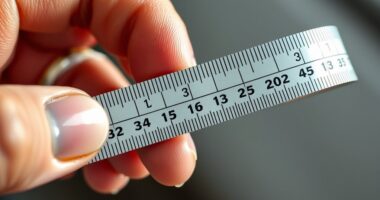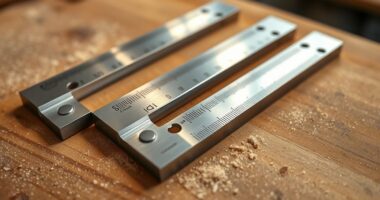To create lightning-fast layout lines using the center-finding rule, start by folding or marking the midpoint between two edges or points on your grid or material. Use a straightedge to confirm the center and mark it clearly. From this point, you can quickly extend lines across your work, ensuring perfect alignment and equal spacing. Mastering this technique boosts your efficiency and accuracy—if you keep going, you’ll discover more tips to streamline your layout process even further.
Key Takeaways
- Use folding or midpoint techniques to quickly locate the center between two points or edges.
- Mark the center point clearly to serve as a reference for drawing layout lines.
- Extend straight lines from the center point to create precise, evenly spaced layout guides.
- Apply the center-finding rule to ensure consistent spacing and perfect alignment across your project.
- This method speeds up layout work, reduces measurement errors, and results in a professional finish.

Have you ever struggled to draw precise layout lines quickly? If so, you’re not alone. Achieving accurate grid alignment and maintaining spacing consistency can be challenging, especially when you’re pressed for time. Fortunately, there’s a simple yet effective technique—the center-finding rule—that can dramatically speed up your workflow and improve the quality of your lines. This method ensures that your layout lines are not only accurate but also consistent, making your project look professional and polished.
Using the center-finding rule starts with understanding how to quickly locate the midpoint between two points or edges. Instead of measuring repeatedly or relying on guesswork, you can fold, mark, or use a straightedge to find the exact center of any section. For example, if you’re working on a grid layout, aligning your measurements to the center points of each grid square ensures perfect grid alignment, which is essential for structural integrity or aesthetic balance. By consistently marking the center points, you create a reliable reference that guides your lines, reducing the chances of skewed or uneven spacing.
Locate midpoints quickly with folding, marking, or straightedges for perfect grid alignment and even spacing.
This approach enhances spacing consistency because it allows you to replicate distances effortlessly. Once you’ve identified the center point of one section, you can transfer that measurement to other parts of your layout, preserving uniform gaps and alignments. It eliminates the need for constant re-measuring, saving time and reducing errors. Furthermore, when you’re drawing multiple lines or creating complex layouts, the center-finding rule acts as a visual anchor, helping you maintain a steady hand and straight lines. This leads to cleaner, more precise results with less effort, even when working under tight deadlines.
Another advantage is that this technique promotes efficiency. Instead of measuring every distance multiple times, you identify the central reference once, then extend your lines from that point. This not only speeds up the process but also minimizes cumulative measurement errors, which can throw off your entire layout. As a result, your work becomes more consistent, with evenly spaced lines and properly aligned elements. It’s particularly useful when you’re working on symmetrical designs or projects requiring exact spacing and alignment, like cabinetry, tiling, or framing.
Additionally, understanding and applying contrast ratio considerations can help ensure your lines are clearly visible and accurately placed against different backgrounds, enhancing overall precision.
Frequently Asked Questions
Can the Center-Finding Rule Be Automated With Software?
You wonder if the center-finding rule can be automated with software. Absolutely, it can! Automated alignment tools and software integration make this process efficient, reducing manual effort. You just need to incorporate specialized design or CAD software that supports center-finding algorithms. This way, you streamline your workflow, improve precision, and save time, ensuring your layout lines are perfectly centered every time without manual calculations.
What Tools Are Best for Drawing Lightning-Fast Layout Lines?
You might think drawing lightning-fast layout lines requires fancy tools, but often, simple chalk lines or laser levels do the trick. Ironically, these basic tools can be more effective than complex software, saving you time. You’ll find that laser levels provide precision and speed, making layout lines quick and easy, especially when combined with the center-finding rule. Sometimes, the simplest tools give you the fastest results.
How Does the Center-Finding Rule Compare to Traditional Methods?
The center-finding rule offers greater precision accuracy compared to traditional manual methods. Instead of relying on guesswork, you use this rule to quickly locate the exact center of lines or shapes, saving you time and reducing errors. Unlike older methods that involve measuring or estimating, this technique streamlines your workflow, allowing you to draw layout lines faster and more accurately, making it ideal for efficient, precise design work.
Are There Specific Materials That Work Better With This Technique?
You’ll find that material compatibility and surface texture greatly influence the success of this technique. Smooth, non-porous surfaces like glass or metal work best because they allow the tool to glide easily and stay accurate. Avoid rough or porous materials, which can interfere with precision. Choosing compatible materials guarantees your layout lines are clear and accurate, making your work more efficient and professional.
Can This Method Be Applied to Irregular or Curved Surfaces?
Imagine embracing a new challenge with a sense of adventure. While the center-finding rule is excellent for flat surfaces, applying it to irregular surfaces or curved geometries can be tricky. You might need to adapt your approach, using flexible tools or marking key points carefully. With patience and creativity, you can successfully extend this technique to more complex shapes, transforming obstacles into opportunities for innovative solutions.
Conclusion
Now that you’ve mastered the center-finding rule, your layout lines will slice through your project like lightning strikes across the sky. With this quick method, you’ll save time and boost accuracy, turning a formidable task into a breeze. Think of it as your secret weapon—faster than a flash and sharper than a thunderclap. Keep practicing, and soon, your lines will be as precise and swift as lightning itself, illuminating your workspace with confidence.









